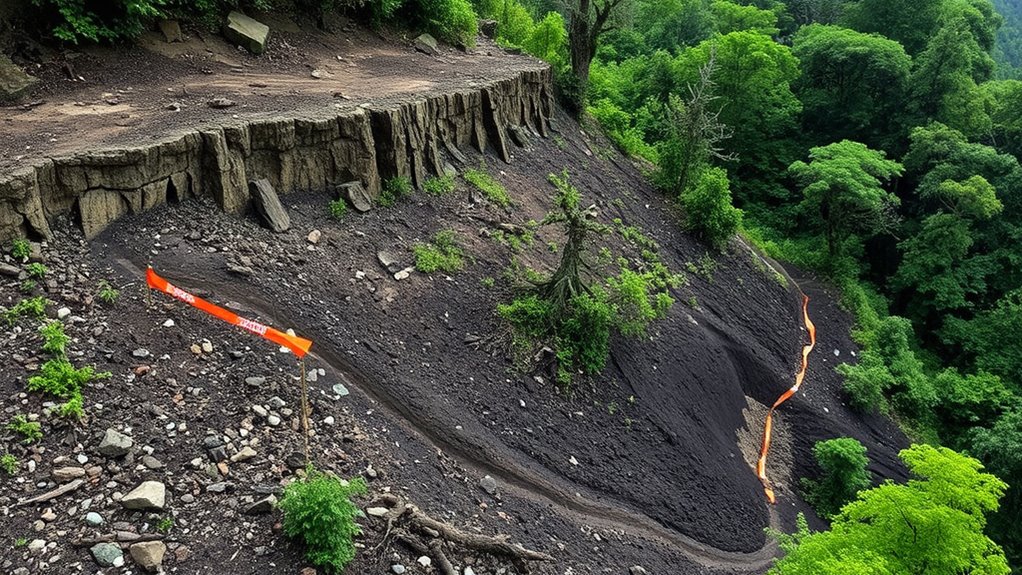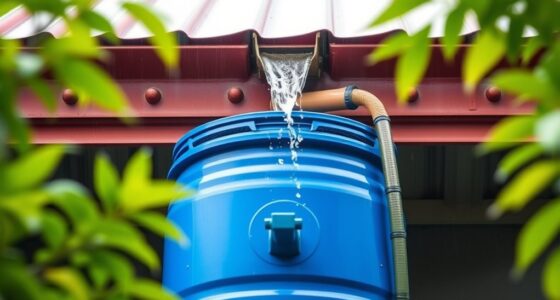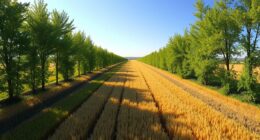To stay safe from landslides and debris flows, watch for warning signs like fresh cracks on slopes, leaning trees or fences, and loose soil on steep terrain. Unusual sounds, pooling water, or sudden landscape changes also indicate potential danger. Keep an eye out during heavy rain or rapid snowmelt, and act quickly if you notice these signs. Continuing your awareness can help you recognize these hazards early and stay protected when it matters most.
Key Takeaways
- Look for visible cracks, leaning trees, fences, or disturbed soil on slopes as early signs of instability.
- Listen for unusual sounds like rumbling, cracking, or shifting noises indicating ground movement.
- Notice water pooling, new springs, or changes in landscape features on slopes that suggest soil compromise.
- Monitor weather conditions; heavy rain or rapid snowmelt can weaken soil and trigger landslides.
- Stay alert to natural indicators like soil cracks and leaning vegetation, and move promptly to higher ground if observed.

Landslides and debris flows can strike unexpectedly, posing serious risks to lives and property. Recognizing the warning signs is essential to protect yourself and others. One of the most important factors to consider is soil stability. When the ground becomes unstable, it can give way suddenly, especially after heavy rain or rapid snowmelt. You should pay close attention to cracks appearing on slopes, leaning trees, or fences, as these are often signs that the soil’s integrity is compromised. Loose or disturbed soil, particularly on steep terrain, indicates that a landslide could be imminent. It’s also important to understand that soil stability isn’t static; it can change with weather conditions, land use, and natural processes, which makes ongoing risk assessment essential. Regularly observing the landscape helps you identify shifts that could precede a slide, giving you valuable time to evacuate or prepare. Additionally, understanding the role of soil composition and moisture levels can provide deeper insight into potential landslide triggers.
Risk assessment plays a central role in landslide safety. This process involves evaluating the area’s susceptibility to landslides by analyzing terrain, soil types, and recent environmental changes. If you live in or are visiting a hillside or mountainous region, take the time to learn about the local risk factors. Authorities often publish hazard maps that highlight zones most prone to landslides and debris flows. Knowing these zones enables you to make informed decisions about where to build, how to landscape, and when to evacuate. Conducting your own risk assessment means staying alert to recent rainfall levels, as heavy rain can weaken soil stability and trigger slides. Also, monitor any changes in the landscape, such as new construction or deforestation, which can destabilize slopes and increase the risk.
Understanding warning signs allows you to act swiftly. Aside from visible cracks and leaning trees, listen for unusual sounds like rumbling or cracking that may indicate shifting ground. Water pooling or the sudden appearance of new springs on a hillside can also suggest that the soil’s stability is compromised. If you notice these signs, it’s best to move to higher ground immediately and avoid slopes vulnerable to movement. Keep emergency kits ready and stay informed through local alerts and weather updates. Proactive risk assessment combined with vigilance for early warning signs empowers you to respond effectively before a landslide or debris flow occurs. Remember, the key to safety is not just recognizing the signs but acting promptly to minimize danger and protect your life and property.
Frequently Asked Questions
How Can I Distinguish a Landslide From Other Natural Events?
You can distinguish a landslide from other natural events by observing geological indicators and pre landslide signs. Look for cracks in the ground, leaning trees, or new fractures on slopes, which signal instability. Sudden shifting of the earth, increased water saturation, and unusual sounds also warn of an impending landslide. Recognizing these signs early helps you act quickly and stay safe before the event occurs.
What Immediate Actions Should I Take During a Debris Flow Warning?
During a debris flow warning, you must act fast—like lightning striking! Immediately evacuate to higher ground following your evacuation procedures, avoiding valleys and slopes. Grab your emergency kit, including essentials like water, medications, and important documents. Stay updated through alerts, and don’t delay—every second counts. Keep calm, move swiftly, and make sure everyone in your household understands the plan, so you all stay safe amid nature’s chaos.
Are There Specific Building Codes to Prevent Landslide Damage?
Yes, there are specific building codes designed to prevent landslide damage. You should guarantee your construction complies with local geotechnical standards and construction regulations, which specify foundation requirements, slope stabilization techniques, and proper drainage systems. These codes aim to minimize landslide risks by guiding safe design and construction practices. Always consult local authorities or geotechnical experts to verify that your project adheres to the latest standards and regulations.
How Do Climate Change Effects Influence Landslide Frequency?
Climate change increases landslide frequency by intensifying climate-induced rainfall and causing temperature-related soil instability. As heavy storms become more common, you face a higher risk of landslides, especially in vulnerable areas. Warmer temperatures melt permafrost and destabilize slopes, while increased rainfall saturates soil, making it prone to sliding. Staying aware of these changes helps you better prepare and implement safety measures against the rising threat.
Can Vegetation Planting Effectively Reduce Landslide Risk?
Planting vegetation can effectively reduce landslide risk by creating natural barriers and stabilizing slopes. You should focus on establishing dense vegetation, especially on vulnerable slopes, to promote slope stabilization. Vegetation barriers slow water runoff, reducing erosion and soil loosening. By integrating these green solutions into land management, you help prevent landslides and protect infrastructure, making your area safer and more resilient against slope failures.
Conclusion
Stay alert to signs like cracking ground, unusual noises, or rapidly rising water, and don’t ignore them—think of it as your modern-day “canary in a coal mine.” Remember, safety isn’t just about avoiding a landslide; it’s about respecting nature’s warnings. If you notice trouble, take action immediately and head to higher ground. By staying vigilant, you can prevent tragedy and keep yourself safe, proving that even in an age of technology, awareness remains your best defense.










